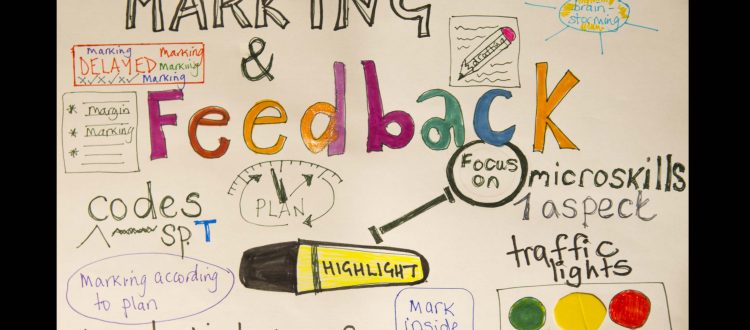Collated tips on marking
I thought I’d share some different ways that teacher can mark written work.
As you may have gathered from my posts on so many different subjects and levels, my teacher training and materials writing work involves collating and creating ideas and tips on many, many different aspects of teaching.
But very often, I find that worlds collide – well, they don’t collide, thankfully, but they do seem to cross over, intersect and complement each other, so I end up finding inspiration from different areas (and fellow teachers and trainers) and from various sources.
On Friday, I was in Bilbao sharing ideas on Engaging Learners in Writing and Assessment of Writing at B2 and C1 and next Friday, I’ll be back there to look at the same topic but this time for A2 and B1.
And I’m also putting together a module for online teacher training on …….
Feedback on Learner Language (Spoken and Written)……..
And I felt in the mood for a doodle, so the image for this post is my doodling on this subject!
So, read on for some different ways of marking – in this case, the teacher, rather than self-correction or peer correction – although that would be the next stage after the teacher input.
Focused marking
You, the teacher focus on one aspect of language or writing:
spelling / punctuation / use of vocabulary / range of grammar / accuracy of grammar (for example, verbs)/ organisation of ideas / relevance to the question, etc.
Just on that one aspect/criteria. Resist the temptation to correct or highlight the rest!
Margin marking
In the margin, you indicate that there’s a mistake on the line, but give no indication of where or what the mistake is.
Delayed marking
You mark the work, using a code, but do not give a mark. The student is given a chance to correct the work and resubmit. This time, a mark is given.
Marking according to plan
Instead of asking students to write, only ask them to write the plan for their answer and assess that.
Traffic lights
Draw green, amber or red circles in different parts of their work. Or highlight the sections/words.
Green = great
Amber = Needs rewording or rewriting
Red = this is not okay/meeting standards
Students correct and try and get green lights throughout their work.
OR
Students draw green, amber or red lights on their work. Green means they feel confident about this part. Or that this where they’ve done what you/the question asked them to. Amber – they’re not sure. And red, they really think that there’s a problem with this part. You help them out.
Marking inside the box
The teacher selects only part of the text to give feedback on. He/she draws a box round the section and only marks that section. Very often, it’s the middle section that needs the most attention!
No correction of text – recommendations at the end
The teacher writes 2-3 bullet points at the end of the writing to suggest how it could be improved.
e.g.
- Replace repeated words

